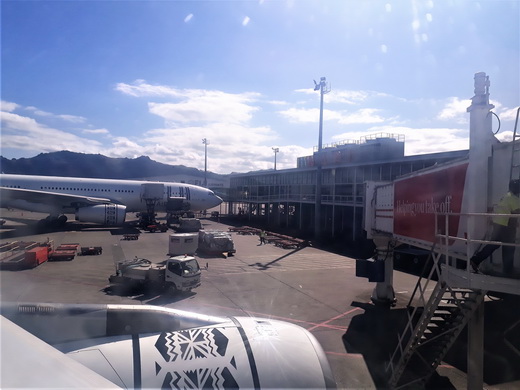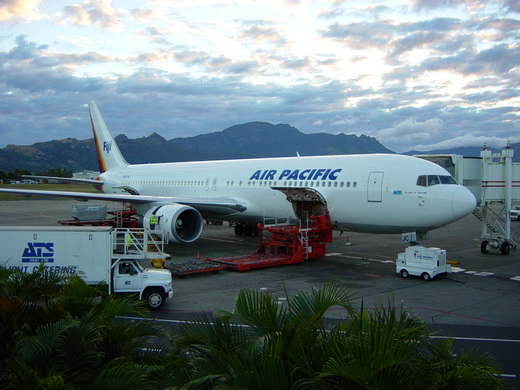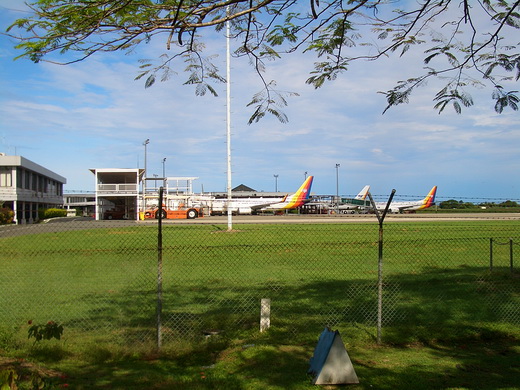 |
|
Nadi International Airport |
Nadi International Airport (IATA: NAN, ICAO: NFFN) is the main international airport of Fiji as well as an important regional hub for the South Pacific islands, located by the coast on the western side of the main island Viti Levu. It is the main hub of Fiji Airways and its domestic and regional subsidiary Fiji Link. The airport is located at Namaka 10 km from the city of Nadi and 20 km from the city of Lautoka. In 2017, it handled 2,291,635 passengers on international and domestic flights. It handles about 97% of international visitors to Fiji, of which 86% are tourists. Despite being Fiji’s main airport it is a considerable distance from the country’s major population centre; located 192 kilometres (119 mi) northwest of the country’s capital and largest city Suva and its airport, Nausori International Airport.
|
Nadi International Airport
|
|
|
|
| Summary |
| Airport type |
Public |
| Operator |
Airports Fiji Limited (AFL) |
| Serves |
Nadi |
| Location |
Nadi, Viti Levu, Fiji |
| Hub for |
|
| Elevation AMSL |
18 m / 59 ft |
| Coordinates |
17°45′19″S
177°26′36″E |
| Website |
airportsfiji.com |
| Map |
Location of airport in Fiji
|
| Runways |
| Direction |
Length |
Surface |
| m |
ft |
| 02/20 |
3,273 |
10,739 |
Asphalt |
| 09/27 |
2,136 |
7,007 |
Asphalt |
|
| Statistics (2017) |
| Total passengers |
2,291,635 |
| International passengers |
2,009,878 |
| Domestic passengers |
281,757 |
|

History
The original airstrips at Nadi were built by New Zealand from August 1939, being completed in March 1940, and were paid for by the British colonial authorities. They were extended by New Zealand from November 1941; the first 7,000 feet (2,100 m) runway was completed by January 1942 and the other two by April 1942. The work was requested by the United States of America for the South Pacific air ferry route and paid for as reverse Lend-Lease. In 1941 American engineer Leif J. Sverdrup discussed progress on the airfields with Walter Nash, then New Zealand Minister of Finance. Nash recalled Sverdrup saying that there was no formal agreement for payment for what was called Nandi Airport by America, so on the back of one of his cards Sverdrup drew a cross representing the airfield, wrote «£250,000» (pounds) and initialled it «L.J.S.» The extension was actually estimated to cost £750,000 (pounds).
The airfield was used by the United States Army Air Forces when the Pacific War began in 1941, as USAAF Nandi [sic]. Early in the war, B-17 Flying Fortresses were flown from Nadi against Japanese targets in the Philippines and Solomon Islands. In 1943, the 42d Bombardment Group flew B-25 Mitchells from Nadi. During this period, the U.S. Navy used the airfield as well, labeling it Naval Air Facility Nandi (NAF Nandi).
After the war ended, control of Nadi Airport was handed over to New Zealand on 20 December 1946, and the Civil Aviation Authority of New Zealand began operations from Nadi in 1947. At independence in 1970, the Fijian government began participating in the organisation of Nadi Airport, and full control was handed over in 1979.
The first tarmac runway was constructed in 1946 at a cost of £46,500; 7,000 feet (2,100 m) by 150 feet (46 m).
Nadi Airport in 1971 showing the open-sided covered walkways between the aircraft and terminal. A Canadian Pacific Air Lines DC-8 is pictured.
Then, as now, Fiji was the crossroads of the Pacific – and in those days was even more important as a refuelling stop. The apron was shaded by palms, crotons and hibiscus trees, with whitewashed stone paths connecting it to the terminal. These have now been lost under concrete as the apron has expanded over the years, as aeroplanes larger in both number and size land at Nadi. In the 1940s and ’50s, the airport’s official name was Colony of Fiji: Nadi Airport, although foreign timetables continued to spell the name in phonetic English: Nandi.
Nadi was selected as the major airport for Fiji mainly due to its location on the drier west coast of Viti Levu.
During the first half of the 1960s, Nadi served as a key airport for transfer of passengers from Auckland’s Whenuapai airport which could only take turboprop and piston aeroplanes, onto the new DC-8s and Boeing 707s bound for North America and Europe. At one time, New Zealand controlled the world’s largest Flight Information Service (FIS), which at its largest stretched to 10,360,000 square kilometres. All of this was controlled from Nadi.
Drama came to Nadi Airport on 19 May 1987. The first coup had just occurred (14 May 1987). Prime Minister Dr Timoci Bavadra and his cabinet were under arrest, and tension continued to rise in the country. Air New Zealand Flight 24 made a scheduled stop to refuel, en route from Tokyo (Narita Airport) to Auckland. Ahmjed Ali, an aircraft refueller, used his security card to board the aeroplane and, once in the cockpit, showed the captain that he was carrying dynamite. He wanted passage out of Fiji and the release of Dr Bavadra. The passengers and cabin crew were able to disembark, while Air New Zealand negotiators in Auckland and Ali’s relatives in the Nadi control tower attempted to defuse the escalating situation. Eventually, the flight engineer hit Ali over the head with a bottle of duty-free whisky, and he was handed over to the Nadi police.
Operations
An aerial photograph of the airport from the southwest. Runway 02 is in the middle of the photo.
Arrivals and departures are much preferred to be to the south, due to the closeness of the Sabeto mountain range to the immediate north of the airport. A large turn around area, suitable for Boeing 747s, is to the left of the threshold of Runway 02, in case meteorological factors make departure to the north necessary.
In 2010, a Qantas Airbus A380 had to make an emergency landing to disembark a sick passenger, showing that whilst not certified, the facilities at Nadi are sufficient to cater for the largest passenger aeroplane in the world. The A380 had no problem landing, but it took Qantas officials in Sydney nearly six hours to develop a plan to ferry the aircraft back to SYD.
Qantas Airbus A380 flight QF8 departed DFW-SYD on January 23, 2020 and diverted to Nadi to offload a female passenger for urgent medical treatment. QF8 landed at approximately 03:27 local time, delays offloading the passenger saw the flight initially redirected to Brisbane due to crew work hours restrictions and it was then redirected to Auckland. The majority of passengers resumed the trip to Sydney on QF 7008 departing AKL at approximately 20:21 NZDT on January 25, 2020.
Today, the largest concentration of hotels in Fiji has grown up in and around Nadi. As tourism took off in the 1960s, the resorts under construction in the nearby Mamanuca Islands and Denarau Island cemented Nadi as the centre of Fiji’s tourism industry.
Nadi is the operational base for Fiji Airways, which services six airports throughout the southwest Pacific, and many more on the Pacific Rim.
The Civil Aviation Authority of Fiji (CAAFI) head office is at Nadi Airport. Fiji Airways has its head office in the Fiji Airways Maintenance & Administration Centre at the airport. In addition, Fiji Airlines Limited, operating as Fiji Link, is headquartered at the Pacific Sun office at the CAAFI compound.
Airlines and destinations
International departures


| Destinations |
| Air New Zealand |
Auckland
Seasonal: Christchurch, Wellington |
| Air Niugini |
Honiara, Port Moresby |
| Air Vanuatu |
Port Vila |
| Aircalin |
Nouméa, Wallis Island |
| Fiji Airways |
Apia–Faleolo, Auckland, Brisbane, Christchurch, Hong Kong, Honiara, Honolulu, Kiritimati, Los Angeles, Melbourne, Nuku’alofa, Port Vila, San Francisco, Singapore, Sydney, Tarawa, Tokyo–Narita, Wellington
Seasonal charter: Beijing–Capital, Hangzhou, Taipei–Taoyuan |
| Fiji Link |
Kadavu, Labasa, Mana, Rotuma, Savusavu, Suva, Taveuni
Seasonal: Vava’u |
| Hibiscus Air |
Pacific Harbour |
| Jetstar Airways |
Sydney |
| Nauru Airlines |
Nauru |
| Northern Air |
Gau, Koro, Labasa, Laucala, Levuka, Moala, Rotuma, Savusavu, Suva, Taveuni |
| Pacific Island Air |
Malolo Lailai, Mana Island |
| Qantas |
Sydney |
| Solomon Airlines |
Honiara, Port Vila |
| Virgin Australia |
Brisbane, Melbourne, Sydney |
The above content comes from Wikipedia and is published under free licenses – click here to read more.
| General Info
|
| Country |
Fiji
|
| ICAO ID |
NFFN
|
| Time |
UTC+12(+13DT)
|
| Latitude |
-17.755392
17° 45' 19.41" S
|
| Longitude |
177.443378
177° 26' 36.16" E
|
| Elevation |
59 feet
18 meters
|
| Type |
Civil
|
| Magnetic Variation |
012° E (01/06)
|
| Beacon |
Yes
|
| Operating Agency |
CIVIL GOVERNMENT, (LANDING FEES AND DIPLOMATIC CLEARANCE MAY BE REQUIRED)
|
| Island Group |
Viti Levu I
|
| Operating Hours |
24 HOUR OPERATIONS
|
| International Clearance Status |
Airport of Entry
|
| Communications
|
TWR
1800-0800Z. OT svc on 119.1.
|
118.1
|
GND
1800-0800Z
|
118.1
|
TRML INFO
Avbl 1600-1000Z dly.
|
127.9
|
| APP |
119.1
|
| FIS |
126.7
|
| RDO |
3467
5634
8867
13261
17904
|
| Communications Remarks |
|
| A/G |
Major World Air Route Area SELCAL
|
| ACC |
Domestic Flight Information Service 3425 6553 8846 11339.
|
| Runways
|
| ID |
Dimensions |
Surface |
PCN |
ILS
|
| 02/20 |
10739 x 150 feet
3273 x 46 meters |
ASPHALT |
080FCXT |
YES
|
| 09/27 |
7007 x 150 feet
2136 x 46 meters |
ASPHALT |
065FCXT |
NO
|
| Navaids
|
| Type |
ID |
Name |
Channel |
Freq |
Distance From Field |
Bearing From Navaid
|
| VOR-DME |
NN |
NADI |
072X |
112.5 |
6.6 NM |
143.3
|
| NDB |
VK |
NAVAKAI |
- |
405 |
2.2 NM |
038.0
|
| Supplies/Equipment
|
| Fuel |
Jet A1, without icing nhibitor.
100/130 octane gasoline, leaded, MIL-L-5572F (GREEN)
|
| Remarks
|
| CAUTION |
BASH
|
| FUEL |
A1 (C 679-720-042) (NC-100)
|
| LGT |
PAPI Rwy 02 PAPI TCH 75'; Rwy 09 PAPI TCH 50'; Rwy 20 PAPI 3.20 TCH 70'; Rwy 27A-PAPI TCH 54'.
|
| MISC |
Whenever possible US mil acft will use Pago Pago Intl, American Samoa in lieu ofNadi. All mil itinerant acft intending to transit Nadi exc in emerg must ctc ATCC (NFFNXR and NFFNQF) at least 48 hr prior to ETD for Nadi.
|
| NS ABTMT |
See FLIP PLANNING AP/3.
|
| OPR HOURS |
H24
|
| RSTD |
Ngt tkof Rwy 20 and ldg Rwy 27 proh.
|
| TFC PAT |
Due to hi terrain to the N and NE of afld, deps fr Rwy 02 must begin lt turn onto hdg 260 mag no later than EOR of Rwy 02. Rwy 09 - rgt turn to 270 aft tkof.
|
The content above was published at Airports-Worldwide.com in 2020.
We don't guarantee the information is fresh and accurate. The data may be wrong or outdated.
For more up-to-date information please refer to other sources.
|
 |



